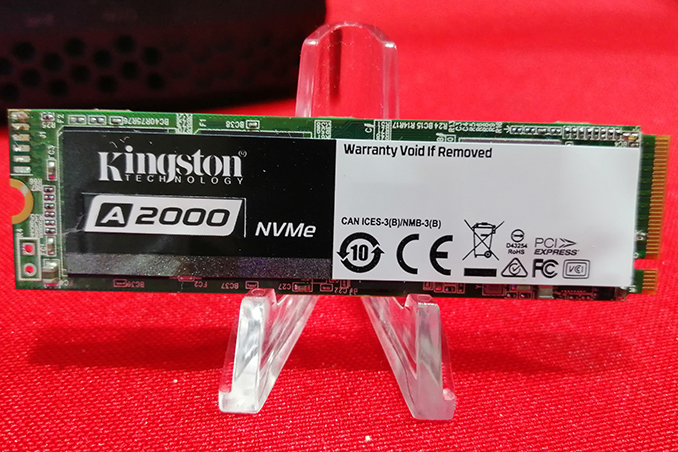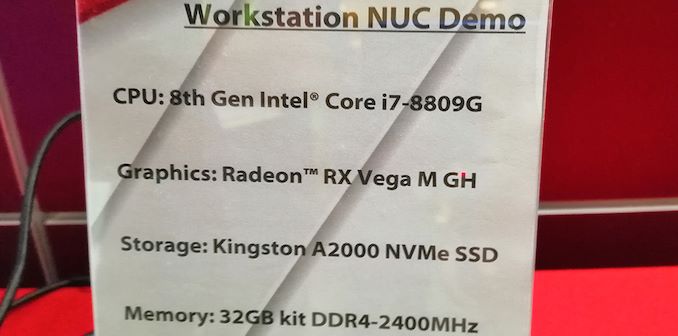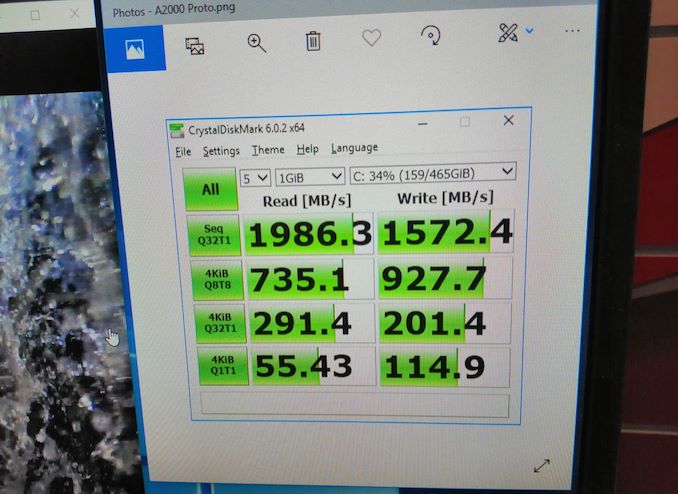CES 2019: Kingston A2000 NVMe SSD Aiming for Below SATA Pricing
by Anton Shilov on January 18, 2019 3:00 PM EST- Posted in
- SSDs
- Storage
- Kingston
- Trade Shows
- Phison
- Silicon Motion
- CES 2019

Manufacturers of SSDs have traditionally sold drives with a PCIe interface at a premium when compared to devices featuring a SATA interface because of higher performance and despite of the fact that most SATA SSDs use drive form-factor and are more expensive to make than M.2 modules. Later this year Kingston plans to launch its A2000-series SSDs featuring a PCIe 3.0 x4 interface that will be priced below SATA SSDs.
The Kingston A2000-series drives will be offered in various controller/NAND configurations in a bid to be flexible in terms of BOM costs and ensure that the SSDs are consistently cheaper than solutions featuring a SATA interface. In particular, Kingston plans to use Silicon Motion’s SM2263-series and Phison’s low-cost controllers along with Toshiba’s BiCS4 3D TLC NAND memory for these drives.
Kingston’s A2000 SSDs will be offered in 240 GB, 480 GB, and 960 GB configurations, which is in line with other low-cost SSDs. As for performance, the manufacturer targets up to a 2000 MB/s sequential read speed as well as up to a 1500 MB/s sequential write speed. A prototype Kingston A2000 512 GB SSD that Kingston demonstrated at CES offered up to a 1986 MB/s sequential read speed as well as an up to a 1572 MB/s sequential write speed. Such performance levels are typical for SMI’s SM2263XT/SM2263 controllers, so these results are not too surprising. Meanwhile, we are looking forward to see official test results of another version of the A2000.
Kingston says that performance of A2000 drives featuring different controllers will be consistent, so end-users will not have to wonder which SSD they are buying, but this claim will have to be verified by independent testing.
| Comparison of Kingston's Client NVMe SSDs | ||||
| Capacity | A2000 | A1000 | KC2000 | KC1000 |
| 240 - 960 GB | 240 - 960 GB | 240 TB ~ 2 TB | 240 - 960 GB | |
| Controller | Silicon Motion Phison |
Phison PS5008-E8 | Silicon Motion | Phison PS5007-E7 |
| NAND Flash | Toshiba's 96-layer BiCS4 3D TLC | Toshiba's 256 Gb 64-layer BiCS3 3D TLC | 3D TLC | Toshiba's 128 Gb planar MLC |
| Form-Factor, Interface | M.2-2280, PCIe 3.0 x4 | M.2-2280, PCIe 3.0 x2, NVMe 1.2 | M.2-2280, PCIe 3.0 x4 | M.2-2280, PCIe 3.0 x4, NVMe 1.1 |
| Sequential Read | Up to 2000 MB/s | Up to 1500 MB/s | Up to 3000 MB/s | Up to 2700 MB/s |
| Sequential Write | Up to 1500 MB/s | Up to 1000 MB/s | Up to 2500 MB/s | Up to 1600 MB/s |
| Random Read IOPS | ? | Up to 120K IOPS | ? | Up to 290K IOPS |
| Random Write IOPS | ? | Up to 100K IOPS | ? | Up to 190K IOPS |
While Kingston demonstrated prototypes of its A2000 -series SSDs at CES, it is not clear when the company intends to ship the final drives. While we do know for sure that Kingston wants to make its A2000-series PCIe SSDs cheaper than SATA SSDs, it still remains to be seen what they will be priced at, especially with NAND prices continuing to fluctuate as the weeks go by.
Related Reading:
- The Kingston A1000 NVMe SSD Review: Phison E8 Revisited
- Kingston Launches A1000 Entry-Level PCIe SSDs: Phison PS5008-E8 with 3D TLC
- Kingston at CES 2018: A 6.4 TB U.2 Enterprise SSD with Four M.2 Behind a PEX Chip
Source: Kingston












15 Comments
View All Comments
lazarpandar - Friday, January 18, 2019 - link
1tb nvme pricing is fine where it's at. We need someone to bring down the prices of 2tb sticks.RamIt - Friday, January 18, 2019 - link
Competition is good even at the bottom. A ~$100 1tb nvme drive is what i have been waiting foreurico - Tuesday, January 22, 2019 - link
Dreaming is definitely cheap...rocky12345 - Friday, January 18, 2019 - link
Drive looks good for a prototype drive and if priced great this might be a good option for my next system build and I can gift my 512GB Samsung 850 Pro drive to my girl friends system and upgrade her form the Samsung 850 EVO 250GB I got her for her last year.Reflex - Saturday, January 19, 2019 - link
These would be fantastic for my QNAP NAS. It has 2 NVMe M.2 slots, and can use them to cache data from the HDDs...Dragonstongue - Saturday, January 19, 2019 - link
so below sata pricing with NO mention of price...good job*clap clap clap*
wumpus - Sunday, January 20, 2019 - link
Cheap is good, but reliability has to be there. Once you go below SATA, I get suspicious. I'm also surprised at the 4x pci-e lanes, most of the cheap stuff goes for 2x (I suspect they can barely fill 2x in sustained read/writes, so I'm happy with that).danielfranklin - Sunday, January 20, 2019 - link
Moving forward it doesnt have to be more expensive.SSDs are a simple build of materials, they use the same NAND, once the controllers are able to be sold to them a the samecosts, they can basically cost the same.
On top of that, using the system RAM for caching and lookup tables allows them to remove the DRAM in low end models, essentially being able to bring the costs below that of a SATA.
Over time SATA will entirely become the legacy option with no new controllers or options, NVME controllers and parts will keep moving forward in every way bringing more performance per dollar.
We will see what we are seeing with the whole SSD market though, which is a greater delta between the high and low end parts.
DRAMless QLC SSDs are going to be very different to a Samsung 980 Pro (If it exists) moving forward...
eastcoast_pete - Sunday, January 20, 2019 - link
Maybe I overlooked it, but the article doesn't mention if it's DRAM-less or not. Given the targeted price range, I assume it is. Since that means that it'll use system memory to cache, is that why it needs 4 PCI-3 lanes to get the speed the demo showed?danielfranklin - Sunday, January 20, 2019 - link
I would certainly assume it is.Not sure if the bandwidth would help, i imagine the issue is more latency than bandwidth, the caching is used more for page lockups than actual data caching i thought.